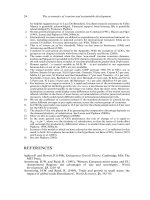THE ECONOMICS OF MONEY,BANKING, AND FINANCIAL MARKETS 393
Bạn đang xem bản rút gọn của tài liệu. Xem và tải ngay bản đầy đủ của tài liệu tại đây (42.08 KB, 1 trang )
CHAPTER 14
A PP LI CATI O N
Risk Management with Financial Derivatives
361
Hedging with Stock Index Futures
Financial institution managers can use stock index futures contracts to reduce
stock market risk.
Suppose that in March 2010, Mort, the portfolio manager of the Rock Solid
Insurance Company, has a portfolio of stocks valued at $100 million that moves
percentagewise one-for-one with the S&P Index. Suppose also that the March 2011
S&P 500 Index contracts are currently selling at a price of 1000. How many of these
contracts should Mort sell so that he hedges the stock market risk of this portfolio
over the next year?
Because Mort is holding a long position, using the basic principle of hedging,
he must offset it by taking a short position in which he sells S&P futures. To calculate the number of contracts he needs to sell, he uses Equation 1.
VA + $100 million
VC + $250 * 1000 + $250 000
Thus,
NC + $100 million/$250 000 + 400
Mort s hedge therefore involves selling 400 S&P March 2011 futures contracts.
If the S&P Index falls 10% to 900, the $100 million portfolio will suffer a
$10 million loss. At the same time, however, Mort makes a profit of 100 * $250 +
$25 000 per contract because he agreed to be paid $250 000 for each contract at
a price of 1000, but at a price of 900 on the expiration date he has a delivery
amount of only $225 000 (900 * $250). Multiplied by 400 contracts, the $25 000
profit per contract yields a total profit of $10 million. The $10 million profit on the
futures contract exactly offsets the loss on Rock Solid s stock portfolio, so Mort has
been successful in hedging the stock market risk.
Why would Mort be willing to forgo profits when the stock market rises? One
reason is that he might be worried that a bear market was imminent, so he wants
to protect Rock Solid s portfolio from the coming decline (and so protect his job).
OP TI O NS
Another vehicle for hedging interest-rate, foreign exchange, and stock market risk
involves the use of options on assets. Options are contracts that give the purchaser
the option, or right, to buy or sell the underlying asset at a specified price, called the
exercise price or strike price, within a specific period of time (the term to expiration). The seller (sometimes called the writer) of the option is obligated to buy or
sell the asset to the purchaser if the owner of the option exercises the right to sell
or buy. These option contract features are important enough to be emphasized: The
owner or buyer of an option does not have to exercise the option; he or she can let
the option expire without using it. Hence the owner of an option is not obligated to
take any action but rather has the right to exercise the contract if he or she so









